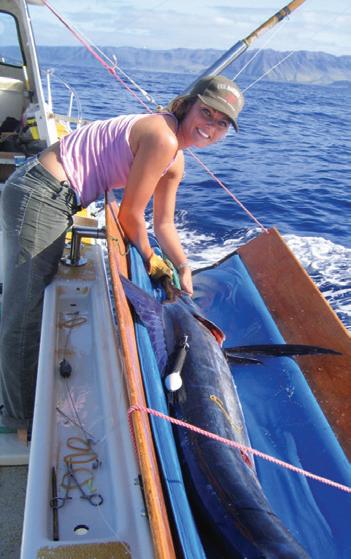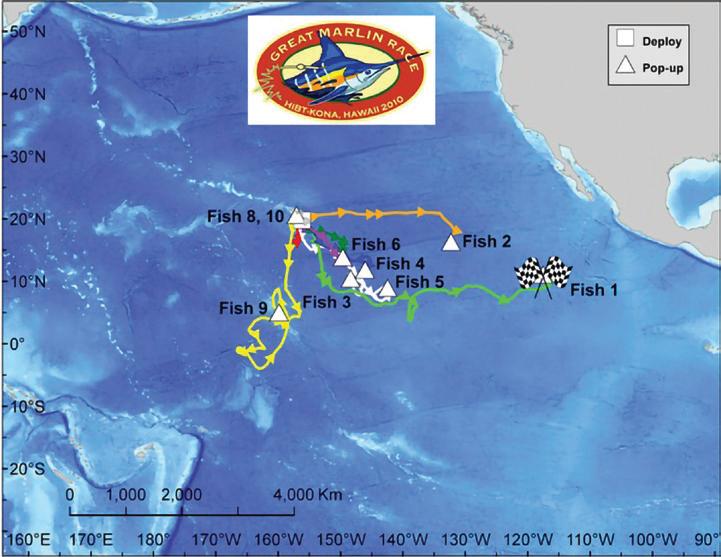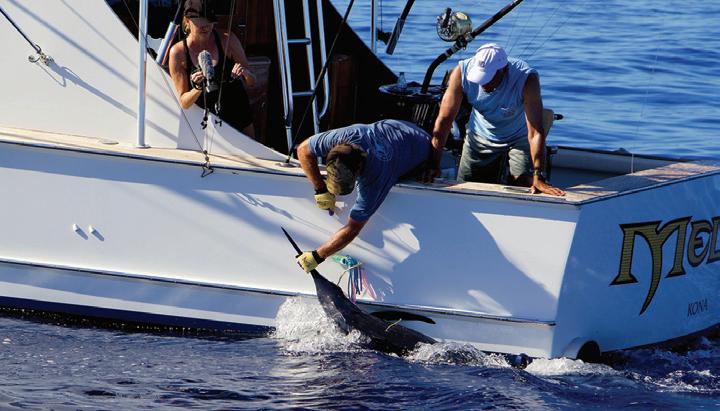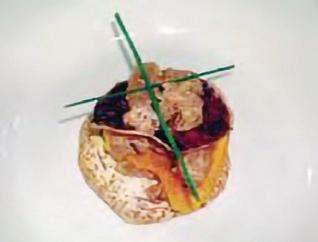
12 minute read
Fishery Policies
from Monograph 10 - History of the Billfish Fisheries and Their Management in the Western Pacific Region
15. Evolution of Billfish Tournaments and Recreational Fishing Policies
The HIBT, first held in 1959, is now considered one of the most important billfish tournaments of its kind. Like all of the billfish tournaments in the United States, the HIBT promotes both the catchandrelease and the tagging of billfish. The place of recreational fishing in Hawai’i has grown since the HIBT was initiated.
Advertisement
In 2011, the charter industry in the State of Hawai’i employed more than 800 people, involved 192 active vessels (106 in the County of Hawai’i, where Kona is located) and generated sales of nearly $50 million (Rollins and Lovell 2019). An estimated 26,000 people fish for billfish in the State of Hawai’i, representing approximately 10% of the U.S. total of 300,000 people who say they have caught a billfish or are interested in billfish fishing (Ditton and Stoll 2003, U.S. DOI and DOC 2018). The charter boat industry also attracts the members of this demographic who have very high disposable incomes. Thus, the industry represents an important market for highend resorts. (Ditton and Stoll 2003, Carter and Conathan 2018).
Currently, approximately 215 to 300 billfish tournaments are held per year on the U.S. mainland and in Central America. These tournaments involve from 20 to 400 entries, with six people per team. Entry fees can be as high as $70,000 per boat (Brakhage 2019). Because of the “Calcutta” option, crews can win $1 million in a single contest. Hawai‘i does not permit gambling but does have cash prizes in its “shoot out” (Miller et al. 2001).
The billfish contest organizers ask their members to practice catchandrelease fishing, so the fish will continue to live.
“It was the jackpot fishermen and their boat captains and crews who wanted catch and release because they didn’t like the waste of fish when more fish were caught than could be sold and the fish were thrown away,” explained Morioka. “However, most boat captains struggle except for those at the high end who take out millionaires or who are the best of the best and become ‘hired guns’ to work the big gambling tournaments on the U.S. mainland. The trend in Kona has been for boat slips to be purchased by millionaires who fish their own boats, leaving the sixpack charterboat fishermen who take out middleclass people to endure as during the depression.”
Furthermore, 14% of the marlin and other billfish that are caught and released are estimated to die from their wounds. This number remains stable regardless of the type of tackle used to catch the fish or whether they are released alive by commercial or recreational fishermen (Musyl et al. 2014). Other studies have placed the mortality rate as high as 26% (Domeir, Dewar and NasbyLucas et al. 2003).
Fig. 28. Tagging a striper in Hawai‘i. Photo: David Itano. Fig.29. The Council sponsored the winner (Fish #1) of the 2010 Great Marlin Race. The fish in the contest were tagged during the HIBT and followed for 120 days.

On the other hand, the HIBT over the years has served as a major source of research information on billfish as a result of its tagging and other scientific programs. As a result of their cuttingedge research using satellite tags, it was discovered that marlin spend 75% of their time in the upper 10 meters of the water column and have specific circulatory adaptation that allows them to recover from long struggles like angling.7
Here, differences emerge with fishing practices in the U.S. Atlantic, where a hard cap of 250 blue and white marlin and roundscale spearfish is in place. The limit was exceeded for the first time in 2020. NMFS implemented mandatory catchandrelease only in the Atlantic for these species on Sept. 30, 2020, through the remainder of the year.
The passage of the Modernizing Recreational Fisheries Management Act of 2018, introduced by U.S. Sen. Roger Wicker (RMS), is indicative of the continued interest of game fishermen in developing new NOAA directions for recreational fishing.

Fig. 30 and 31. Recreational fishing for billfish off Kona, Hawai‘i. Photos: Kevin Hibbard.

16. Proposals for Longline Changes
Despite efforts to educate the general public and young people, with up to three hooks per buoy the Council continues to face skepticism from environmental groups such as Wild Oceans (formerly NCMC), who say the Council’s policies deployed in deep water during the day. They hope longliners can thus avoid interaction with unmarketable and promote “unsustainable and unregulated bycatch” (Hinman 2015). protected species. Swordfish fishermen Opponents of longlining have not asked for an immediate ban on it, as was the case in the Atlantic. Instead, they have been asking for incremental changes in NMFS policy that would have the same effect. For example, they advocate that swordfish vessels stop putting out longlines 10 to 60 miles long with thousands of hooks and instead opt for a buoy system, in the U.S. Pacific have experimented with this system with support from NMFS, the Pew Charitable Trust and others. NMFS reports that markets are receiving the product at a premium and early results of efficient swordfish Fig. 32. Serving blue marlin catches and avoidance of nontarget tempura at the Western Pacific species are encouraging. (NOAA 2017). Regional Fishery Management Council’s booth during the A related problem is the international 2003 NOAA Fish Fry are (l–r) reporting and management of billfish Council Executive Director Kitty to the WCPFC. The WCPFC consists M. Simonds, then Secretary of of 40 countries that include members, Commerce Donald Evans, then member territories and participating NOAA Administrator Conrad C. Lautenbacher and Honolulu nonmembers. The WPRFMC has Chef Russell Siu. Photo: WPRFMC. provided it with resources, technical expertise and hosting sites since 2004.


Efforts are made to protect and manage tuna and billfish, but the motivations Spicy A‘u Tartare of participating countries are different. Despite some improvements, reporting remains inconsistent and incomplete. Courtesy of Chef Grant Sato, Kapiolani Community College’s Culinary Institute of the Pacific, Honolulu
These points were made by Simonds Serves 6 in her testimony to Congress: Ingredients The U.S. fleet in the Western and 1 lb small diced a‘u (marlin or swordfish)
Central Pacific Ocean (WCPO) is 1 tbsp salt comprised of 30 purseseine vessels 2 tbsp water targeting skipjack tuna, 144 Hawai‘i ½ cup green onions, chopped based longline vessels targeting 2 tbsp wasabi tobiko bigeye tuna and swordfish, and 1 tsp sriracha sauce 13 American Samoa longline vessels 1 tbsp oyster sauce targeting albacore tuna. The U.S. fleet competes in the WCPO against much larger foreign fleets, such as China with 78 purseseine and 524 longline vessels, Chinese Taipei 1 tbsp red ebi flakes 1 tbsp toasted seasame seeds 2 tbsp mayonnaise ¼ lb sweet potato or taro chips Fig. 33 Spicy A‘u Tartare. Photo: WPRFMC. with 34 purseseine and 1,009 Preparation and Plating longline vessels, and Japan with 66 purseseine and 434 longline vessels. With 2,425 longline vessels in the WCPO, foreign fleets comprise 94% Salt the a‘u and sprinkle with water. Toss lightly and set aside for a minute. Place the a‘u in a bowl, add all of the other ingredients and stir well to combine. Serve chilled with chips. of the longline vessels in the WCPO.
The U.S. fisheries operating in Simonds continued by saying, “the by marine advocacy organizations. the WCPO are among the most U.S. and foreign fleets in the WCPO The common view seems to be highly regulated, monitored and operate in the same high seas waters that longlining anywhere poses an enforced fisheries in the world. up to the boundary of the U.S. EEZ. existential threat to existing billfish
Our fisheries adhere to a broad However, foreign vessels are required stocks. The cumulative effect of this range of regulations compared to have 5% observer coverage.” Thus, advocacy is to push legal, regulated to other nations. Besides the as Simonds noted “the playing field is U.S. fishing efforts further to the
MagnusonStevens Act, they are vastly uneven.” In contrast, the Hawai‘i margins and thereby expose both subject to the Endangered Species longline fishery is subject to 100% obser American consumers and our natural
Act, Marine Mammal Protection ver coverage for its shallowset sector resources to unexpected risks.
Act, National Environmental Policy and 20% observer coverage for its deep This presents a dilemma for fishery
Act and Antiquities Act, among set sector. It must report in near real managers at the Council. others, as well as federal regulations time and has high levels of monitoring They realize that, when fewer fish implementing conservation and when it lands in port. are legally caught in U.S. waters, more management decisions of the The consequence of this high level fish will be caught by less regulated
WCPFC. (WPRFMC 2019b) of regulation has ensured that, in fisheries on the open ocean to fill the the U.S. Western Pacific, blue marlin market need. In a world where people stocks are healthy are hungry for protein, this situation and striped marlin creates further incentive for some are designated foreign vessels to fish illegally. overfished but are However, they also realize that, actively monitored after more than 70 years of careful and part of an research, if managed correctly, the ongoing recovery U.S. zone has sufficient billfish for both plan. Unfortunately, recreational fishermen and consumers. the accomplishments With no outside markets in which to of fishery managers legally sell it at present, billfish are now in maintaining stocks in such a surplus that large amounts in Fig. 34. Due to the BCA amendment, the ban on interstate commerce of Hawai‘i-caught billfish (except swordfish) caused the price and demand while supplying U.S. markets have Hawai‘i have no value and are said to be thrown away at sea (see Appendix 3). for fresh marlin to fall, which led some in the industry to focus on other gone unrecognized ways to prepare and market the fish. Source: Sylvia Spalding.

17. Conclusion
Since 1976 the Western Pacific Regional Fishery Management Council has played a key role in the development of billfish management in the United States. It was among the first to help federal regulators exclude foreign fishermen from the U.S. EEZ. The Council developed management policies that recognized and incorporated the different needs of the groups competing for billfish in the region: the artisanal fishermen, the highend recreational fishermen and the local commercial longline fishermen. Council members were able to develop their initial policies by working closely with scientists and fishery analysts capable of using data from a multitude of Japanese, Korean, U.S. and other sources.
When conflicts over swordfish took place in the Atlantic Seaboard and the Gulf Coast, concurrently with the discovery of untapped swordfish stocks off Hawai‘i, the result was a largescale influx of fishing vessels that quadrupled Hawai‘i’s longline fleet within five years. It resulted in a major environmental crisis and a conflict between the new comers and local artisanal and recreational fishermen.
The Council took action and instituted one of the first largescale open ocean closures in the United States. Its actions were praised by recreational fishermen in groups such as the IGFA, which held as a model the Council’s 1991 Protected Species Zone, which excluded longline operations within 50 nm of the NWHI. The Council would later point out that despite this increase fishing pressure, 20 years later the Pacific blue marlin stocks which had been declared overfished in 1977 were declared healthy, while striped marlin is being put on a recovery plan. Hawai‘i, which was always a popular fishing spot, continues to be worldrenowned for producing more “granders” (billifish over a 1,000 pounds) than virtually any other place. Longliners and artisanal and recreational fishermen learned to coexist and sold locally caught marlin to buyers all over the world. The sale of the marlin, which was prohibited on the continental United States, helped sustain the local longline fleet, which currently contributes 1,134 jobs to the Hawaii economy. Many of the workers in the fleet are people from Hawai‘i and the U.S. Pacific Islands.
Over time recreational fishing and environmental interest on the U.S. mainland, which once had worked with the Council to incorporate tuna into the MSA, came to criticize its actions. They successfully lobbied for a policy of closures to longline vessels that dictates that 51% of the U.S. EEZ in the Western Pacific Region are now marine national monuments, with bans on U.S. commercial fisheries, and up to 83% of the U.S. EEZ around Hawai‘i is closed to U.S. long line fishing vessels—even though the longline vessels have 100% observer coverage on swordfish vessels and 20% coverage on tuna vessels. This forces all but a few of the Hawai‘ibased longliners to transfer their efforts to the international waters of the high seas. There they must compete with largely unregulated fishing vessels from Asia and elsewhere, most of which do not report their billfish landings, do not have observer coverage and generally able to sell fish to U.S. consumers through a system in which as much as onethird of seafood imports may be from IUU fishing (Pramod et al. 2014).
The year 2020 has also had a number of negative impacts on all sectors of Hawai‘i’s billfish fishery. The effect of COVID19 on Kona charterboat fishermen in Honokohau harbor, which is largely dependent on tourism, has seen many local fishermen suffer from lack of clients, and the longline fishery has the double penalty of not only the pandemic but also the 2018 amendment to the Billfish Conservation Act, which alone dramatically dropped fish prices by more than 51%. All but those businesses catering to the ultrahighend recreational game fish market have suffered.
The combination of the BCA and COVID19 have affected the ability of many local workers to remain employed in the fishing industry. There is a concern that the proposed largescale closures will result in further unemployment because owners of fishing vessels will find themselves forced from the fishery. Because of the generally healthy state of the Western Pacific billfish stocks, the benefits of these new closure policies and others destined for the Western Pacific in name of conservation are unknown. However, what is recognized is that Hawai‘i residents and Pacific Islanders who have few economic options other than fishing will likely disproportionately bear the burden of any economic costs from these policies.

Fig. 35. Orange-colored nairigi fillets indicate they are seasonally fatty. The prized fillets make excellent sashimi and poke. Photo: Hawaii Seafood Council.







